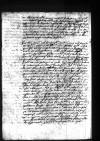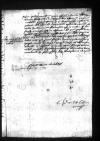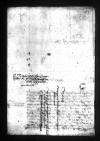Cum istas occlusissem et ⌊cubicularius Spiegel⌋, quod navis parata nondum erat, abire non potuerat, aliqua adhuc scitu digna neque incommoda ad sacram ⌊regiam maiestatem⌋ adnotavi venitque mihi etiam in mentem, ut de his, quae dominum ⌊Cornelium Scepperum⌋ spectant, sicut ⌊regia et reginalis maiestas⌋ mihi scribi mandarunt, Dominationem Vestram Reverendissimam certiorem redderem. ⌊Is⌋ ad praesens hic non est, exspecto tamen ex ⌊Brugis⌋ cotidie eius adventum. Non video, quibus modis ⌊ipse⌋ duobus dominis posset servire, praesertim cum ⌊caesar⌋ in variis et longinquis legationibus opera eius plerumque utatur. Licet sciam ⌊illi⌋ in propensione inserviendi sacrae ⌊regiae et reginali maiestati⌋ nihil deesse, non tamen conveniret in hac curia, ubi etiam facili de re ingens nasci solet suspicio, quod ille et ⌊caesari⌋, et regiae atque reginali maiestati servire deberet. Posset in eo servitio fidem, quam de ⌊eo⌋ concepit ⌊caesar⌋, amittere et nescio quae non in rem suam neglegere.
Perlatum est item ad ⌊eum⌋, quod aliquando serenissima ⌊reginalis maiestas⌋ de eo male senserit, habens de eo opinionem, quod esset homo ebrius et nullius usui vel momenti apud ⌊caesarem⌋, quod tamen longe aliter se habet. Sic interdum illius ⌊reginalis maiestas⌋ suis ineptis Italiolis credens, de bonis viris aliam, quam debet, opinionem concipit, quae raro commodare solet. Nihilominus cum domino ⌊Cornelio⌋, quando advenerit, agam libenter iuxta id, quod mihi praescriptum est. Sed satius et consultius mihi videretur, quemadmodum et sacrae ⌊reginali maiestati⌋ scripsi, ut aliquis nostras ingenio et industria praeditus, qui ad minus praeter Latinam haberet perfectam linguam Italam, unde facile Hispanicum disceret, huc mitteretur, quem quantum possem instituerem et in amicorum meorum notitiam deducerem, qua commode hic ⌊regiae et reginalis maiestatis⌋ rebus et negotiis inservire posset experireturque hic aliquid et disceret, quo deinde ⌊reipublicae regni⌋ utilior fieret. Hoc facit quo serenissimus ⌊rex Angliae⌋, qui quamdiu in ista curia fui, septies mutavit oratores. Itidem faciunt ⌊Veneti⌋, qui ad eum modum per totum orbem quo possunt suos mittunt oratores  BNW, BOZ 2053, TG 14, No. 1607, f. 43v et illis quibuslibet annis mittunt successores, non quod illis non credant, sed ut etiam alii discant, quos postea ad officia et in senatum assumunt, quibus hucusque respublica illorum et non paucis annis plus quam ⌊illa vetus Romana⌋ duravit. Haec non igitur scribo, ut aiunt, cf. Cic. Ac. I 4.18; Cic. Fam. IX 18.4; Fest. 310M ⌊sus Minervamcf. Cic. Ac. I 4.18; Cic. Fam. IX 18.4; Fest. 310M ⌋, sed animi mei iudicium ea in re Dominationem Vestram Reverendissimam latere nolui, quae illud pro sua prudentia et benevolentia erga me boni consulat.
BNW, BOZ 2053, TG 14, No. 1607, f. 43v et illis quibuslibet annis mittunt successores, non quod illis non credant, sed ut etiam alii discant, quos postea ad officia et in senatum assumunt, quibus hucusque respublica illorum et non paucis annis plus quam ⌊illa vetus Romana⌋ duravit. Haec non igitur scribo, ut aiunt, cf. Cic. Ac. I 4.18; Cic. Fam. IX 18.4; Fest. 310M ⌊sus Minervamcf. Cic. Ac. I 4.18; Cic. Fam. IX 18.4; Fest. 310M ⌋, sed animi mei iudicium ea in re Dominationem Vestram Reverendissimam latere nolui, quae illud pro sua prudentia et benevolentia erga me boni consulat.
Redeo iterum ad consensum matrimonii inter ⌊regiam et reginalem maiestatem⌋, ab illustrissima ⌊olim matre⌋ reginalis maiestatis promissum et non impetratum, quem ego, ut scripsi, summa cura et diligentia a ⌊maiestate caesarea⌋ obtinui, quoque superinscribed in place of crossed-out opt(?)⌈opt(?)quoquequoque superinscribed in place of crossed-out opt(?)⌉ Dominatio Vestra Reverendissima cognoscat, cf. Verg. A. I 33 tantae molis erat Romanam condere gentem ⌊quantae molis eratcf. Verg. A. I 33 tantae molis erat Romanam condere gentem ⌋. Venit huc ad curiam superiore anno dominus Ludovicus Gonzaga, qui contraxerat matrimonium cum domina Isabella de Columna, ut peteret a⌊ maiestate caesarea⌋ consensum habuitque intercessores ⌊summum pontificem⌋, ⌊cardinalem Columna⌋, ⌊ducem Mantuae⌋ multosque alios principes atque totam ⌊Columnensium domum⌋, tam bene longo tempore de caesare promeritam, et toto anno praeterito consensum istius sui matrimonii a caesare numquam impetrare potuit text damaged⌈[it]it text damaged⌉ iamque fere desperaverat. Nunc tandem paulo ante opera text damaged⌈[ra]ra text damaged⌉ ⌊pontificis⌋, serenissimi ⌊Romanorum regis⌋ multorumque aliorum cum summa difficultate magnoque dispendio etc. consensum istum obtinuit.
Ne putet ergo superinscribed⌈ergoergo superinscribed⌉ sacra ⌊reginalis maiestas⌋ rem esse adeo levem, quam tanto labore et conatu pro illa assecutus sum neque putet praeter verba nullum me pro sacra maiestate eius procurasse commodum, quandoquidem sine eo consensu post contractum et consummatum matrimonium omnibus bonis suis feudalibus in ⌊regno Neapolitano⌋ fuisset exuta. Hoc servitium libenter et magno animi cum ardore sacrae ⌊maiestati eius reginali⌋ impendi et non minore affectu, cura et diligentia ad praesens negotiis maiestatis eius sum impensurus, id sibi omnino Dominatio Vestra Reverendissima persuadeat, quicquid umquam in mea erit facultate et per me praestari poterit, modo ⌊caesar⌋ velit, qui talis est, ut scripsi in novissimis.
 BNW, BOZ 2053, TG 14, No. 1607, f. 44r
BNW, BOZ 2053, TG 14, No. 1607, f. 44r
Non potui omittere, quin effigiem ad vivum illustrissimi domini ⌊ducis Frederici comitis palatini Rheni⌋ Dominationi Vestrae Reverendissimae mitterem. Quae si prius a serenissima ⌊regia maiestate⌋ visa non est, poterit illam ostendere. Lineamenta optime conveniunt, sed certe humanior et formosior est in vultu, quam sit fusus et expressus in argento. Et cum aurum et argentum non est mihi, mitto hoc aereum Christi Passionis Dominationi Vestrae Reverendissimae simulacrum et meum plumbeum, sum quidem plumbeus totus on the margin⌈meum plumbeum, sum quidem plumbeus totusmeum plumbeum, sum quidem plumbeus totus on the margin⌉, et rogo per opportunitatem egestatis meae, si quod forsan levamen mihi afferri possit, coram sacra ⌊regia et reginali maiestate⌋ non obliviscatur Dominatio Vestra Reverendissima, cui me iterum summopere commendo, nihil maiore desiderio cupiens, quam illam videre brevi incolumem et felicissimam.
 BNW, BOZ 2053, TG 14, No. 1607, f. 44v Reverendissimo Domino meo
BNW, BOZ 2053, TG 14, No. 1607, f. 44v Reverendissimo Domino meo  BNW, BOZ 2053, TG 14, No. 1607, f. 43r Reverendissime Domine.
BNW, BOZ 2053, TG 14, No. 1607, f. 43r Reverendissime Domine.
 BNW, BOZ 2053, TG 14, No. 1607, f. 43v et illis quibuslibet annis mittunt successores, non quod illis non credant, sed ut etiam alii discant, quos postea ad officia et in senatum assumunt, quibus hucusque respublica illorum et non paucis annis plus quam
BNW, BOZ 2053, TG 14, No. 1607, f. 43v et illis quibuslibet annis mittunt successores, non quod illis non credant, sed ut etiam alii discant, quos postea ad officia et in senatum assumunt, quibus hucusque respublica illorum et non paucis annis plus quam  BNW, BOZ 2053, TG 14, No. 1607, f. 44r
BNW, BOZ 2053, TG 14, No. 1607, f. 44r



